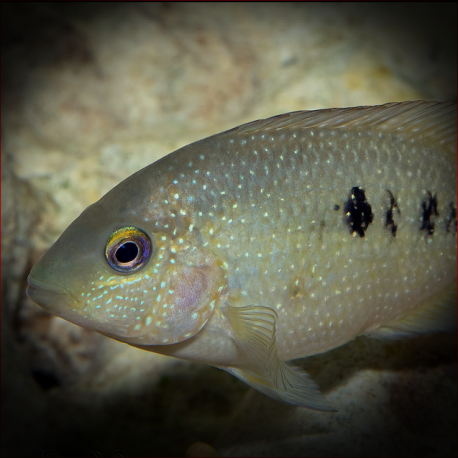More info
Datasheet
| Minimum Tank Size | 255 litres / 67.36 US gallons |
| Maximum Size | 30.0cm / 11.81inches |
| Temperature | 20°C / 68.00°F - 33°C / 91.40°F |
| Hardness | 5-12ºdH |
| pH | 6.0-7.5 |
General Description
Members of the species Herichthys Cyanoguttatus, commonly known as the Texas Cichlid, are larger cichlids known for their belligerent and territorial behavior, especially prominent in males. They can grow up to 30.0cm in size and have distinct sexual dimorphism, with adult males being larger and developing pointed fin extensions.
Aquarium Setup
To house Texas Cichlids successfully, a tank of at least 255 litres with a length of 5-6' is required. The setup should include a deep substrate of sand or fine gravel, smooth rocks, driftwood, and large clay flowerpots for refuge and potential spawning sites. Plants that root into the substrate are not recommended due to the fish's digging behavior. Clean, well-oxygenated water with a pH of 6.0-7.5, hardness of 5-12°dH, and a temperature range of 20-33°C is essential. A robust filtration system and regular water changes are necessary for maintaining optimal water quality.
Behaviour
Texas Cichlids exhibit highly territorial behavior, particularly in smaller tank setups. They are aggressive towards tankmates, especially during breeding periods. These cichlids are known to be robust eaters, consuming a varied diet of live and frozen foods along with vegetable matter like peas, spinach, and Spirulina-containing foods.
Feeding and Diet
In the wild, Texas Cichlids primarily feed on aquatic invertebrates but also ingest plant matter and detritus. In a captive environment, they eagerly consume a variety of foods, including quality dried products supplemented with live and frozen options. Offering vegetable matter is crucial, and a balanced diet promotes their overall health.
Reproduction & Dimorphism
Breeding Texas Cichlids can be successful with a compatible pair in a well-prepared tank with ample spawning sites like rocks and flowerpots. Adult males exhibit sexual dimorphism by being larger with extended fins and sometimes developing a nuchal hump. The breeding process involves courtship behaviors, egg laying on selected surfaces, and attentive parental care after hatching.
Habitat and Distribution
Texas Cichlids are native to the Rio Grande drainage in the southern United States and Mexico. They prefer slow-moving waters with submerged rocks, tree branches, or dense vegetation. Although originally found in specific regions, they have been introduced to other areas outside their natural range, including Florida, where they have established flourishing populations.

